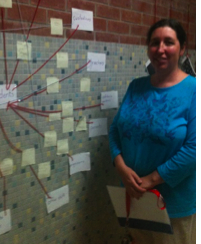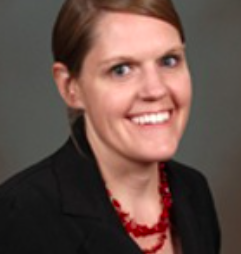AZTESOL News is our official publication full of teaching tips, conference news, legislative updates, reviews of books/journals/websites/apps, and articles on all manner of topics relevant to ESL teachers in every setting. AZTESOL NEWS - JANUARY 2016  Letter from the Editors My New Year’s resolution is to be more aware of the people in both my personal and professional life. This goal is reflected in this January 2016 issue of AZTESOL News where Sumayya Granger and Lorraine Green interview teachers with different ELT roles; Rafael Avalos reveals how he came to better understand parents who work as farm workers; and where Carol Navarette reminds us that people learn languages differently than academic content. Our Legislative Update addresses the personal as well: Jenny Slinkard shares a link for your voice to be heard regarding accountability under ESSA and reports that advocacy is a shared professional role. Undoubtedly, being interested in others helps us to build deeper relationships which benefits our ability to collaborate on projects. Predicting that collaboration is even more important in 2016, we've created an easy collaborative project where all AZTESOL members can contribute. Since we all have our favorite internet resources, we've created a shared document to act as a repository. There Lori Doemland starts us off with a list of her favorite pronunciation sites ready for all of us to share with each other. I'm hopeful this project will bring us all closer together and lead to more collaborations in 2016. -Wanda There are some important deadlines for AZTESOL NEWS, as well as some general guidelines that we'd like to remind you about for our 2016 issues.
Unsolicited Article Categories
Thanks for all your hard work and valuable contributions to the profession! -Adam We wish you a happy and prosperous 2016! President’s Message AZTESOL President’s Message I would like to welcome all the AZTESOL members to an exciting year which many of you started by participating in the Annual State Conference which was hosted by TL3C at Mesa Community College. Congratulations to the four members elected to the board during the annual meeting at the State Conference. Nora Reyes of TL3Cis now the Second Vice President; Nancy Hamadou of Pima Community College is now the Rules and Regulations Officer; Megan Garvy of TL3C is our brand new SIG Coordinator, and Judy Nguyen of ASU’s Global Launch is the AZTESOL Historian. Serving on the AZTESOL Board of Directors can be a rewarding experience in collaboration and communication with ELL professionals across the state. Please consider running for office next year. The Second Vice President will be nominated and elected again next summer/fall when we hope to implement our digital voting via our email list serve, so if you are interested, please look out for an announcement for nominations in the summer. This position is a three to four-year commitment, as the Second Vice President becomes the First Vice President, then the President, and finally, the Past President. It is a valuable professional development and leadership opportunity in the ESL community, and in order for our organization keep maturing and expanding with innovative ideas and community sharing, we need your participation, your service, your expertise, and your enthusiasm! Speaking of enthusiasm, I would also like to commend the interest expressed in the new Refugee Concerns SIG. With the refugee crisis forefront in our daily lives, it is good to know that community partners and concerned parties across the state can start to share teaching and advocacy resources that our refugees need. Plans are being made for the new SIG to have a workshop at AZTESOL’s Southeast Regional Conference to be held on February 6 in Tucson. Please check AZTESOL’s Conference page for updates. As of October, AZTESOL now has more than 650 members. The mission of AZTESOL “is to maintain a forum for concerns affecting the ELL/ELT communities and to create opportunities for professional development through advocacy, dissemination of information, and networking.” AZTESOL is your organization. If you have ideas, comments or questions regarding the mission of the organization and how we can better support our membership, please feel free to email me at tanyatercero@yahoo.com. Thank you all, Tanya Tercero
Spotlight Amy Busse by Lorraine Green What classes do you teach? I teach third grade at Myers-Ganoung, an elementary school in Tucson's Unified School district. Tell us about the English Language Learners that you teach. In my current class, many of my students come from other countries including Mexico, Cuba, Rwanda, Congo, and the Marshall Islands and have limited, if any, English language skills. Can you tell be a bit about your school/district in general? We are the largest district in Tucson. Our school, Myers-Ganoung, has a great deal of diversity in where our students are from as well as having several self-contained special education classes that serve students with diverse abilities. The students are surrounded by different perspectives, which makes our school a great place to learn about getting along in a complex world. Tucson Unified School District is one of Arizona’s 216 districts. According to the Arizona A+ Report Cards website, during the 2013-2014 school year ,the district served over 51,000 students in 84 schools. The district has a rigorous English Language Development (ELD) program, provides refugee and language interpretation services for the parents of our ELD students. Interpreters for Arabic, Swahili, Kirundi, Somali, and many other languages, are offered upon request. What is the focus of your teaching? My primary goal is to help my students develop English conversational skills. In order to accomplish this task, I use the district's adopted curriculum designed specifically for these students. The curriculum focuses on oral language development, vocabulary development, grammar learning, and reading skills. Each school day dedicates a four hour block to cover the curriculum. What do you like best about teaching English Language Learners? What is most challenging? I most enjoy learning about my students’ homelands and cultures. The biggest challenge is the constraints of the teaching day - that limited time is available time to fully explore my students’ beautiful creativity. Is there a special project that was especially rewarding to work on with your students? At the beginning of the year, we were reading about communities in our district textbook, Avenues. Rather than just using the topic as a language arts unit, we made it an interdisciplinary unit about communities. We started by looking at our school and classroom as communities. Then we expanded to our neighborhood and city. I gathered other books and articles about communities to add to our discussions. We built communities with blocks and with paper. Students built up their vocabulary in many different experiences around community and this allowed my students who are just starting to use English a chance to participate in activities that used other skills they had that have. I am determined to keep adding to our reading units so that my students can be exposed to other subject areas, like art, science, and social studies within the 4 hour English block. Right now my students are incredibly excited about studying rocks and fossils, which is part of our current district sponsored science kit. I am looking to the students’ observations and questions to expand the unit and plan a satisfying culminating experience with the students. I can’t wait to see where it will go. Is there a way people in the community can connect with your school? Many members of our staff seek out community resources for our students. Our website (http://edweb.tusd1.org/MyersGanoung/) has our contact information, including teacher email for anyone who wants to connect with us. Spotlight Kayla Dorff by Sumayya Granger What class(es) do you teach? ELD II, III (Basic, Intermediate) at Mansfeld Magnet Middle School in Tucson Unified School District. Tell us about the English Language Learners that you teach. I have sixth through eighth grade students, whose first languages include Arabic, Nepali, Spanish, and several African languages. Many students' families sought better opportunities and moved their families from Mexico and Nepal, while others are refugees who escaped war and political unrest in Chad, Rwanda, and Iraq. My students love to sing and dance and to talk about movies, video games, skateboarding, and soccer. Tell us about your school and your district. Tucson Unified School District is the largest and most diverse school district in Tucson. Mansfeld Middle is a STEM magnet school, so we incorporate science, technology, engineering, and math practices into our teaching and learning. For example, in the ELD department we tie grammar to math by teaching sentence structure as a series of formulas. Tell us about one of your best teaching moments working with English Language Learners. This is my first year working with ELLs. (I taught Spanish previously.) I cannot pick a particular moment, but my ELD II (Basic) class makes my day every day. They are eager to learn and excited to show off the new English they have acquired. Is there a special project you've worked on with students that you'd like to discuss? We recently took our ELD students to see a special exhibit at the Tucson Museum of Art. The exhibit featured art made by refugee students in the community---some were made by our own students! Students also toured CENTER, a program whose purpose is to connect non-English-speaking students and their families in the community. Is there a way community folks can connect with your school? On Facebook or Twitter: MansfeldMiddle Spotlight Veronica Noyce by Sumayya Granger What is your teaching role? I'm an ELD Resource Teacher. I teach ELD Pullout, grades K-5th. I give an hour of focused English Language instruction to each grade level, based on their individual proficiencies, with an emphasis on oral language and vocabulary acquisition. I do a fair amount of phonemic awareness instruction, especially at the primary level. I provide support in a specific area of Language and Literacy, in a Mainstream school setting. When schools have 20 or fewer ELLs across the grade levels, they must receive targeted instruction in a regular classroom setting, with additional support from an ELD instructor. As that instructor, I pull the students into a smaller group setting for an hour per day, at each grade level. With Reading, Oral Language and Vocabulary, Grammar, and Writing, the total hours required for ELL-focused instruction comes to 4 hours per day across the content areas. We make a specific plan for this instruction, and additional curriculum materials are used, as well as Structured English Immersion techniques. So, their regular classroom teacher must have an SEI endorsement as well, and I work in collaboration with them to provide specialized instruction. English Language Development instruction varies a bit from school to school, depending on the total ELL population, and the school focus. For instance, at a Bilingual or Dual-Language school, ELD instruction is in both English and Spanish. Tell us about the English Language Learners that you teach. The population of ELLs at my school are a diverse group. I have taught students whose home-language is Spanish, Vietnamese, Tagalog, Kirundi, Arabic and Russian. Most of these students may speak little or no English if they come in at the primary level, Kindergarten through 1st grade, so I tend to have more students at these grade levels, at varying proficiencies. ELL students in 2nd grade through 5th are usually fewer, as many become proficient before entering 3rd grade. Sometimes the teacher and their parents may decide they need to return to the ELD program, even if they've passed the state mandated test for English previously. In which case, I will sometimes see students who were reclassified for a short time, but still need support. This year, I did gain two students in the Intermediate grades (4th and 5th), whose home language is Spanish, but they had never had ELD instruction before because they are coming from another country. I have been very pleased at their growth, and it is wonderful to see them gain proficiency in a second language. While I encourage them to keep using their home language and celebrate their culture, it is a big deal when they go from speaking little or no English, to speaking and even writing English in as little as a year. I don't take entire credit for this--their classroom teachers, supportive parents, and socialization with peers who speak English, who are willing to partner up and work for their academic benefit, are all integral to their ultimate success. Sometimes, I may have a student for only one year, and their family may move, either to another neighborhood or another state. This is sometimes the case with immigrant and refugee families. It is my greatest hope that I and their teachers in the regular classroom had some positive impact, so they may continue their growth after they leave us. Tell us about your school and your district. Inez Ford Elementary School is located on the far East side of Tucson, in the Tucson Unified School District. Our mission statement is currently "Ford Elementary School is a caring and cooperative environment in which students are taught to strive for their maximum potential intellectually, physically, and emotionally. In order to promote this atmosphere, parental support and participation at this school is encouraged and valued." This pretty much speaks to the atmosphere at my school, which is a friendly place to work and learn. Restorative Practices are used to encourage positive behaviors, and we are a "Kind School" with a beautiful Ben's Bells "Be Kind" mural on the school entry-way. I have worked at this school for almost three years, and have made it a point to get to know the area and the neighborhood, although I live 12 miles away. It has been worth the trip, because the kids and staff are great! Tell us about one of your best teaching moments working with English Language Learners. I really enjoy integrating art, social studies or science into the language curriculum, and working in small groups makes this very easy, which is great for my ELLs, as they need that differentiated instruction. One of our favorite projects in the 4th grade group is to build a "Native Home" and a "Totem Pole", using natural and found materials. We read the themed text, and research other information on the Internet. We collect the materials to make the homes right here at school, as we have a lovely, large playground next to a stretch of desert vegetation. We always find great natural materials, and the kids love our "nature walks" and collecting things to build the homes. The pride they have when the home is complete is very palpable, and we put the completed work on display in the library. Students I've worked with at any proficiency really respond to these hands-on lessons. One student, who passed her state English test last year, still writes me little letters with artwork, even though she is no longer in ELD pull-out. She says it was her favorite class. Those "ah-ha!" moments, when students understand a new concept, or have their faces light up at the completion of a good project, who still communicate with me even after they have moved on, are what make it all worthwhile. How can we connect with your school? Our school website is http://edweb.tusd.k12.az.us/Ford/ (there is possibly a PTA walkathon – more information would be available by contacting the office). Also, we have Reading Seed volunteers. If anyone is interested in that program, they can contact www.literacyconnects.org/volunteer. a Granger earned her PhD in Linguistics and currently works in administration student academic support at the Center for English as a Second Language at the University of Arizona. a Granger earned her PhD in Linguistics and currently works in administration student academic support at the Center for English as a Second Language at the University of Arizona.Parental Involvement: My Experience with Farm Worker Parents by Rafael Avalos Yuma County is recognized for its agriculture and labor. A high percentage of our ELL students' parents work in the agriculture fields and coolers. These are extremely physically demanding jobs with long hours, low salaries, and placing workers at high risk for injury. Working in this environment, parents recognize the demands of the job and the sacrifices they make to provide food, shelter, and clothing for their families. As result, parents want their children to succeed in their education and find competitive jobs that will allow them to have a bett Due to the time constraints these parents face, they know the importance a good education and want to be involved; however they simply do not have the time during school hours or early evenings to provide the at home support needed. On top of this, many are also English Language Learners who have not had this level of education. They have the drive to help their students, they just lack the time and the knowledge of the American school system to assist their children. In addition to the above struggles, many students come every morning from the Mexican side of the boarder to our schools. Due to this unique situation, with their parents located across the border, it is difficult for schools and parents to communicate and monitor their child’s progress. When I worked for San Luis middle school in 2008, I had very few parent-teacher conferences. During the few conferences I was part of, we spoke Spanish since in San Luis Arizona, the primary language is Spanish, and it is comfortable for everyone to use that language. I remember sending a note to the mother of a student misbehaving in my Social Studies class requiring parental signature. He returned that note to me, but I knew my student’s writing, and I noticed the signature was forged. I did not mention that I caught it to my student. Three weeks later, his mother requested a parent-teacher conference to discuss her son’s low grades and performance. She told me that he claimed that he was doing well in school and was improving his grades. I explained to my student’s mother that was impossible to erase his past performance with one or two weeks of slight improvement. I told his mother that I tried to make contact with her several weeks earlier showing her the note hers on falsified. After that meeting, my student improved, but not enough. I remember another student who was bringing a Mead composition book for notes and practice. I suggested another type of notebook to the student. We discussed that the notebook should be easy and micro perforated for clean tear-outs. He could use those sheets to do math work and deliver his practice to me for revision and assessment. Two or three days later, I was called for a parent-teacher conference and met my student’s grandfather. His grandfather wanted to inform me that he bought the notebook for his grandson and he’s willing to follow the school and my directives to support his grandson’s education. His grandfather was elderly, wearing old clothes, giving me the impression he was a man with limited income and resources. I could see his effort and dedication to support his grandson despite of all his possible problems. After that meeting, I felt bad about my request, but it was a good experience to see the love and effort from my student’s grandfather first hand. His grandson worked hard and excelled in my course. As we know, there are many benefits derived from appropriate parental involvement in the ELL student’s curriculum and activities. Those benefits include student’s engagement in school activities, academic achievement, student motivation to learn, and student participation in extracurricular activities such as sports,music and arts. The parents of ELL children can be strong allies in their children’s education if teachers and administrators can find ways to value and capitalize on the strengths of ELL families (Niehaus & Adelson, 2014).
Project Based Learning is Worth the Effort By Rachel Butler As a new teacher, I am constantly on the lookout for ways to support the English Language Learners in my class. A teaching method that I am trying this year is the use of Project Based Learning (PBL). So far PBL has been effective at getting students to believe they can accomplish a task, in part, because they collaborate and, in part, because they have an authentic context for the work they’re asked to produce Project Based Learning allows for independent exploration. According to the Buck Institute for Education website, Project Based Learning “is a teaching method in which students gain knowledge and skills by working…to investigate and respond to an engaging and complex question”. Project Based Learning builds college and career readiness skills through a collaborative, real world work process that celebrates success through presentations of final products. PBL also aims to give opportunities to use technology and make lesson more engaging for students. According to Bas (2008), PBL is a needed, natural evolution of the traditional concept of projects as ways to enhance learning. Bas also points out that the foundational principles for PBL are in no way new to the educational world. In Bas’ paper, PBL is noted as an appropriate method for ELL students because of its real-world feel. He states, “Project-based learning functions as a bridge between using English in class and using English in real life situations”(Bas, 2008, p.2). This is because collaboration with group members requires students to learn how to express themselves, plan, organize, delegate responsibilities, and come to consensus within an academic context. Students’ attempts to do this are facilitated by the assistance and encouragement they can receive from other group members. In my school district, we use the Cambridge Curriculum almost exclusively. This means that my Freshmen English class is high rigor and writing intensive which can, obviously, be a challenge for students who are still learning English. I feel that PBL has the potential to help close the gap between what students feel they can accomplish and what I am asking them to accomplish. In my class, PBL takes the form of cooperative groups working to utilize real world applications for the writing styles I teach. We write reviews of products and T.V. shows to demonstrate summary skills, Public Service Announcements for Informational Writing, and practice debate while learning to write argumentatively – this last becomes extremely applicable to the real world as we near the next presidential election. I feel that using formats students may see in the world outside of school helps to create context in a class that would otherwise be very much context reduced. Creating this context helps to facilitate understanding of the language by ELL students. Further scaffolding of concepts is provided simply because students are working cooperatively with their peers. Students are able to give and receive help as they explore the writing concepts we discuss in class. Additionally, PBL allows students to explore different types of input and encourages the integration of audio and visual components with the written work. This further provides context for ELL students while helping to meet the needs of all learning styles. Within the framework of PBL, I am also able to provide additional support for my ELL students. This support comes in the form of sentence frames to learn how communicate collaboratively in an academic setting, graphic organizers, in class writing workshops, and verbal assessment. PBL lends itself to such scaffolding because of its basis on principles of group collaboration and support. PBL also gives me the opportunity to do much more personalized remediation when students are struggling. I can pull a few students out of their groups to work more closely with me on skills they are struggling with and then send them back to their groups to practice with the support of their peers. This increased ability to differentiate instruction based on need is a wonderful aspect of PBL. Implementing this method is well worth the effort. References What is project based learning? (2015). Retrieved 10/07, 2015, from http://bie.org/about/what_pbl Whyproject based learning? (2015). Retrieved 10/07, 2015, from http://bie.org/about/why_pbl Bas,Gokhan. (2008) Implementation of multiple intelligences supported project-basedlearning in EFL/ESL Classrooms. Retrieved from eric.ed.gov |










 Carol Navarette is a Senior International Educator with Global Launch at ASU
Carol Navarette is a Senior International Educator with Global Launch at ASU